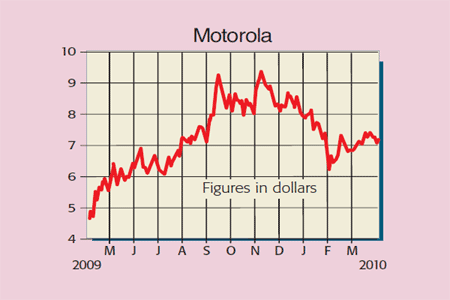
Mobile broadband use rocketed 43% in 2009 to a record 271 million subscribers. That leap was driven by the launch of blockbuster smartphones, such as Apple’s iPhone, RIM’s Blackberry and Nokia’s E-series. So where does that leave Motorola – a leader in home networking products, mobile devices and network infrastructure?
The company has endured a torrid time over the past four years. Back in 2006 the stock traded at $26 as the firm’s iconic Razr became the world’s top-selling handset. Since then, though, its share of the mobile-phone market has plummeted from 23% to an all-time low of 3.7% in the final quarter of 2009. The big problem is poor execution – nimbler rivals have introduced far more stylish and functional products.
But all is not lost for investors. Firstly, in 2008 the group hired turnaround specialist Sanjay Jha. He’s shaken up its sleepy corporate culture. Product innovation is now centre stage, as evidenced by the recent success of smash-hit devices Cliq and Droid. A further 20 smartphones, including the highly acclaimed Backflip, are set to be rolled out later this year.
Motorola (NYSE: MOT), tipped as OUTPERFORM by Sanford Bernstein
Elsewhere, costs have been slashed and nearly 70% of senior executives have been replaced. With the ship now stable, the strategy is being taken one step further; there are plans to split the group into two separately listed stocks by early 2011. One will focus on developing handsets and home entertainment products, such as set-top boxes, and the other on selling wireless equipment, such as 4G LTE and WiMax kit. Both will exploit Motorola’s cutting-edge technology and tier-1 brand.
This is exactly the right approach. The firm’s networking products should benefit greatly from the predicted 39-fold jump in mobile data traffic by 2014. That’s an average growth rate of 108% per year. Wireless operators will have little choice but to spend big bucks upgrading the broadband capacity of their existing mobile phone and associated infrastructure. Moreover, the division should enjoy an upswing from the American government’s $7bn broadband stimulus plan.
With mergers and acquisitions activity surging back, I would not be surprised if the demerger triggered a slew of takeover approaches over the next 12 months. In fact, several parties have already been rumoured as possible acquirers of the handset unit. These include ZTE of China and Samsung/LG Electronics of Korea. On the networking division side, the likes of Huawei, Cisco or even Ericsson would surely be interested.
But how much is the stock worth? On a sum-of-the-parts basis, I rate the networks and handset divisions respectively on 1.2 and 1.0 sales multiples. Once adjusted for the $4.1bn cash pile, those generate a fair value of approximately $27.5bn, equating to roughly $11.5 per share. Certainly, Motorola is not for the nervous investor. Competition is intense, and a double-dip recession would pull down the proceeds from any disposal. However, with the fundamentals for wireless communication favourable, Motorola still rates as good value. Results for the first quarter 2010 are scheduled for 29 April, while Sanford Bernstein has a $10.5 price target.
Recommendation: BUY at $7.3
• Paul Hill also writes a weekly share-tipping newsletter, Precision Guided Investments